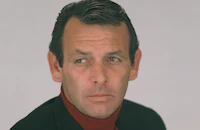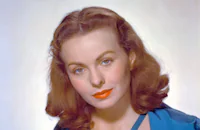Twenty Plus Two

Brief Synopsis
Cast & Crew
Joseph M. Newman
David Janssen
Jeanne Crain
Dina Merrill
Agnes Moorehead
Brad Dexter
Film Details
Technical Specs

Synopsis
Private detective Tom Alder, who specializes in finding missing persons, links the murder of movie star Leroy Dane's secretary to the unsolved disappearance of heiress Doris Delaney several years before. Later, Alder meets Dane and Linda Foster, Alder's former fiancée who broke with him while he was in Korea. He also meets a young woman named Nikki Kovacs, and although he is not aware that Nikki is actually the missing heiress, he senses something familiar about her. He then is approached by Frenchy Pleschette, a man who tries to hire him to find his missing younger brother. After meeting Nikki on a plane, Alder remembers that they met in Japan while he was recuperating from a combat wound. It is then revealed that she had become involved with a man who made her pregnant and whom she thought she had killed. She had run away to Japan to avoid disgracing her family. Alder's further investigations also establish Dane as the killer of both his secretary and the man whom Doris thought she had murdered. He is also revealed to be the brother of Pleschette, and in a showdown between the two, the latter kills Dane. Alder and Doris resume the romance that started in Japan.

Director

Joseph M. Newman
Cast

David Janssen

Jeanne Crain

Dina Merrill

Agnes Moorehead

Brad Dexter

Robert Strauss
Jacques Aubuchon

William Demarest
George Neise
Fredd Wayne
Carleton Young
Robert H. Harris
Billy Varga
Teri Janssen
Ellie Kent
Mort Mills
Robert Gruber

Will Wright
Crew
Ralph Butler
Scott R. Dunlap
Gerald Fried
Frank Gruber
Frank Gruber
Carl Guthrie
Eylla Jacobus
Joe Kish
Harry Maret
David Milton
Edward Morey Jr.
Ted Mossman
Gordon Murray
Milt Olsen
Lindsley Parsons Jr.
George Satterfield
Charles Schelling
Paul Schmutz Jr.
Norah Sharpe
Roger J. Weinberg
James West
George White

Film Details
Technical Specs

Articles
Twenty Plus Two
Crain stayed popular through the mid-1950s, especially in Cheaper by the Dozen (1950) opposite Myrna Loy and Clifton Webb and Gentlemen Marry Brunettes (1955). Then she ran into the classic bind of the Hollywood actress - where to go after the next cadre of youthful, wholesome beauties starts knocking on the door. Rehabbing a self-destructive singer played by Frank Sinatra in The Joker Is Wild (1957) was one solution. Then there was Twenty Plus Two (1961), in which Crain plays a slightly tarnished girl next door. It's as much a who-is-it as a whodunit, with various characters concealed beneath assumed identities. It's up to David Janssen's investigator specializing in locating missing heirs to sort them out. The film took its title directly from Frank Gruber's novel, but it unfairly seems the kind of title that's slapped on when a more compelling one can't be imagined.
More straight detective caper than noir, it nevertheless has plenty of night scenes, and director Joseph M. Newman has a good eye for particulars of architecture and style. The exteriors are dominated by flat, rectangular structures which remind us that Kennedy-era architecture was decidedly on the bland, monolithic side. Newman, obviously working on a tight budget, keeps most of the action inside, though, and the interiors range from the nondescript to the ugly. The design of the film's world, however, matters less than the flawed design of the film itself. It stumbles out of the starting gate, and never really settles into a comfortable gait as Janssen's gumshoe follows the trail of breadcrumbs from Los Angeles to New York to Chicago to a Nebraska farmhouse.
The film's title, the poster assures us, breaks down to 20 clues and two beautiful women - Crain and Dina Merrill. Janssen's private eye is the unknowing link between them. He had been engaged to Crain's svelte, feather-cut hairstyled Linda, who sent him a Dear John letter when he was in the army in Tokyo. Helping him get over the romantic angst is a patrician American beauty (Merrill) working as a dance hall hostess near the Ginza. Under her brunette Jackie Kennedy wig, she's obviously on the lam. Cut to civilian life, and Janssen's private eye, Tom Alder, is sucked into a case with a possible link between the murder of a fan mail and clipping service secretary and the whereabouts of a teenaged heiress and socialite who disappeared 20 years ago. The ever-poised Merrill turns up again, too, with a different hair color. Also materializing is Jacques Aubuchon, whose corpulent seeker, flowery of speech, seems to be channeling Sydney Greenstreet's Kasper Gutman of The Maltese Falcon (1941) fame, and can't throw thousand-dollar bills fast enough at the private eye to locate his younger brother.
The narrative corkscrews on, and the blunt fact is that Crain is given little to do but chase after Janssen's gumshoe in an effort to rekindle their romance. There are only so many ways to portray a rejected woman, although you have to admire her character's doggedness as she boards plane after plane to pin him down. The film is not without entertainment value, although a lot of it comes from around the edges. As a fake war hero and actor with some ugly secrets, Brad Dexter seems to be the only performer having fun here, although Agnes Moorehead is her usual superb self in a scene as the missing heiress's mother, chewing the scenery a bit - but it's delicious to watch her do it - as she scornfully denounces parapsychology as a way of finding her long-lost daughter and gives the detective a green light to pick up the search.
In the end, Twenty Plus Two might have surmounted its maladroitness except for two pieces of bad luck. It caught Janssen between his two longest-running TV series - Richard Diamond, Private Investigator (1957-'60) and The Fugitive (1963-'67) - and thus missed out on capitalizing on his TV popularity. The film's black and white visuals are a plus, and Gerald Fried's jazzy period score is an even bigger one. But Twenty Plus Two has the feel of an overextended TV episode. Janssen suggests neither of his two iconic TV characters so much as Craig Stevens' Peter Gunn. With his Cary Grant chin and unadorned Jack Webb manner, Janssen's private eye is just too cool and too laid back at feature length not to cost the film some of the energy and propulsion it needs. Not that it kept Janssen out of TV's hall of fame for his two iconic TV roles. Nor was TV inhospitable to Crain, who mostly went on to appear on the small screen until her retirement.
By Jay Carr














